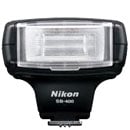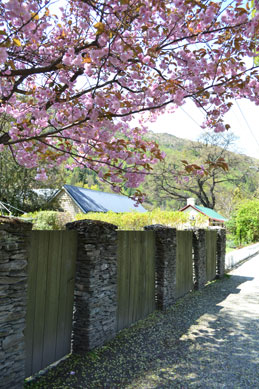Nikon D3100
-
-
Written by Gordon Laing
In depth
Nikon D3100 design and controls
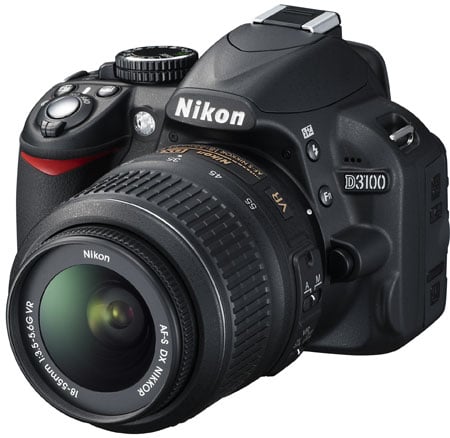 |
In terms of mass, the D3100 body and battery weigh-in at around 500g, which is a little lighter than the earlier D3000, albeit matching the Canon EOS 1000D / XS. Fit their respective kit lenses though and there’s a small difference as the Nikkor 18-55mm VR kit lens is a little longer and 65g heavier than the Canon. As such the EOS 1000D / XS entry-level kit enjoys a small advantage in overall size and weight, but this difference is unlikely to be a deal-breaker for the Nikon. Build quality between these entry-level models is essentially the same – they feel good in your hands without any creaks or poor joins, but don’t expect any weatherproofing or much protection against significant impacts.
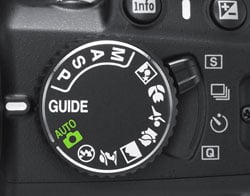 | |
|---|---|
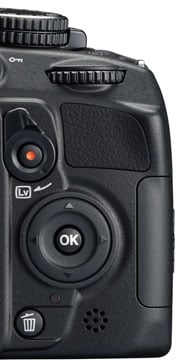 | |
|---|---|
Looking at the D3100 from the top and rear, it again shares the same style and basic layout as its predecessor, but with two major control differences: round the edge of the exposure mode dial you’ll now find a four-position lever to set the drive mode, while to the upper right or the screen on the back a new spring-loaded lever to enter Live View, after which the red button in the middle will start and stop video recording.
The Live View lever has a satisfyingly tactile feel as you twist it with your thumb, while the addition of a drive mode lever is a classy touch for an entry-level model – it certainly makes it quick and easy to select, say, continuous shooting or the self-timer.
Eagle-eyed Nikon followers may also notice there’s now five buttons to the left of the screen rather than four. There’s actually the same number of functions on offer, but on the D3100, zoom-in and information edit ‘i’ now enjoy their own dedicated buttons. We’ll describe how the i control works later in the review.
As before, the main control on the rear is a four-way rocker with an OK button in the middle. Like the D3000, this is unlabelled to make the camera as unintimidating as possible, although it equally means the D3100 misses out on the opportunity to directly select menu pages for common settings, such as for the sensitivity and white balance. While there may now be a dedicated drive mode lever, pretty much everything else requires you to delve into the often laborious screen-based interface, more of which later.
There is some relief in the programmable Fn button though, located just below the flash button by the lens mount. This can be set to offer direct access to the Image quality, ISO, White balance or Active D-Lighting options.
Note there’s still no optical depth-of-field preview on the D3100, although Sony’s entry-level Alpha doesn’t have one either. Canon is standing relatively alone in the budget category by offering one on its EOS 1000D / XS.
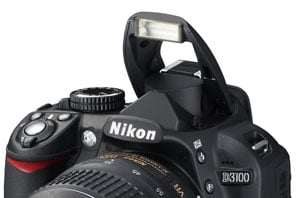 | |
|---|---|
|
The Nikon D3100 is equipped with both a popup flash with a Guide number of 12 and a hotshoe for external flashguns. Flash compensation and power level is adjustable, and you can also choose from red-eye, slow-sync and rear-curtain options. The built-in flash Guide number increases to 13 with manual control, which matches that of the Canon EOS 1000D / XS; both beat the relatively weak popup flash on the Sony A290 which has a Guide number of 10. The D3100’s built-in flash can either popup automatically or by pressing a button on the side of the head, and once you’re finished with it, just push it back into place.
Like its predecessor, the D3100’s maximum flash sync speed is an average 1/200, leaving us to fondly reminisce about the discontinued D40 which inherited the surprisingly quick 1/500 flash sync speed of the much older D50; ironic since both were entry-level models. If you mount a compatible flashgun like the SB-400, SB-600, SB-800 or SB-900, the D3000 can support the Nikon Creative Lighting System (CLS) which offers iTTL control.
On the right side of the body (as it’s held for shooting) you’ll find an SD memory card slot that’s now compatible with the latest SDXC standard in addition to SD and SDHC. Cards rated as Class 6 or faster are recommended for the HD movie mode.
On the left side of the body you’ll find the ports behind a large flap. In addition to the analogue TV output and USB port of its predecessor, the D3100 adds the mandatory Mini HDMI port, along with a proprietary connector for the optional MC-DC2 wired remote control or GP-1 GPS unit.
In a compartment underneath the body you’ll find the new rechargeable EN-EL14 Lithium Ion battery pack, rated at 1030mAh and good for around the same 550 shots as its predecessor, under CIPA conditions. In general use, we managed around 200 shots with plenty of Live View compositions and several minutes of video recording. Battery life is shown on-screen using a three segment indicator, but unlike higher-end models in the range, there’s no menu showing a precise percentage of remaining charge. After filming an uninterrupted ten minute 1080p clip with a fully charged battery, the three segment indicator fell to one.
Nikon D3100 viewfinder
The Nikon D3100 shares the same viewfinder specification as its predecessor: a penta-mirror system delivering 95% and 0.8x magnification. Technically speaking, the apparent size of the D3100’s viewfinder falls fractionally below that of the Sony A290 and Canon EOS 1000 / XS, but look through all three one after each other and you’re unlikely to notice any difference – in terms of coverage and apparent size anyway.
The markings through the D3100 viewfinder do however look different to the earlier D3000. The D3000 impressively featured a transmissive LCD focusing screen, which allowed focus point markings to disappear when not active, while additionally offering an alignment grid which could be switched on and off as required. This was a really nice feature to find on a budget DSLR, but sadly Nikon’s swapped it on the D3100 for a more conventional screen with fixed etchings which remain in place when the camera’s switched off; suffice it to say, there’s no longer an on-demand alignment grid either. It also means rather than using black LCD rectangles for each AF point, they’re now illuminated with red dots when active.
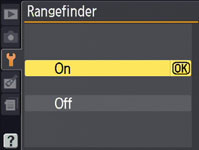 |
The information running below the viewfinder image remains the same as before, which means there’s still no ISO value shown at all times. Like the D3000 before it, there’s also no IR sensors to switch off the screen as you compose with your eye against the viewfinder, but the default timers turn the screen off pretty quickly, and there’s always the INFO button to do it manually if required.
An interesting feature inherited from the D60 and D5000 is the Rangefinder option, enabled in the Custom Function menu. This uses the exposure compensation scale in the viewfinder (but not on the main screen) to indicate focus distance while manually focusing. As you approach perfect focus, the scale reduces to just two markers either side of zero.
Nikon D3100 screen and live view
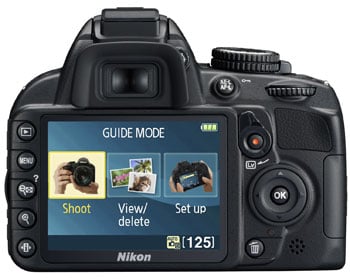 | |
|---|---|
The Nikon D3100 is fitted with the same 3in / 230k / 320×240 pixel fixed screen as its predecessor, which is somewhat of a disappointment considering the panels available today and the camera’s elevated price. To be fair, it is bigger than the 2.5in / 230k screen on the cheaper Canon EOS 1000D / XS, but falls behind on brightness and viewing angle.
Meanwhile, the similarly-priced EOS 500D / T1i boasts a 3in / 920k VGA screen with much finer details, while spend a little more on the EOS 550D / T2i and you’ll enjoy a 3in / 1040k monitor which matches the 3:2 shaped images which all these cameras capture, allowing them to fill the screen. Place the D3100 next to any of these cameras and the image looks duller and coarser, while in our tests also suffering from quite visible smearing in strong sunlight. If this all sounds harsh, don’t get us wrong, the D3100’s screen is okay, but just falls behind its rivals and is ultimately disappointing given the rest of the camera. It’s also worth noting Nikon’s own D5000, which costs roughly the same as the D3100, features a fully articulated (albeit slightly smaller) 2.7in / 230k screen.
One of the headline new features of the D3100 is Live View, a capability sorely lacking from its predecessor. Some traditionalists may still not see the point in Live View, but the ability to compose with the screen has many advantages over the viewfinder, for both beginners wanting the familiar operation of a point-and-shoot, and enthusiasts who’ll exploit magnified focusing assistance direct from the sensor and superimposed graphics. As such it’s a key new feature for the D3100 and while the implementation is similar to the D5000 before it, it boasts a brand new capability we’ve not seen on any Nikon DSLR so far.
To enter Live View on the D3100, you flick the spring-loaded lever by the corner of the screen with your thumb – this control has a classy and satisfyingly tactile feel to it compared to a plain button. A second flick of the lever will exit Live View unless the built-in timer does it for you first.
When first entering Live View you’ll notice the timer in the upper left corner counting down from 30 seconds. Pressing any button will effectively reset the counter back to 30, but once it hits zero, the camera will exit Live View. Nikon doesn’t state whether this is to save power or prevent overheating, but the manual does say it may not appear straightaway. We’re not sure when it wouldn’t appear though, as it started counting down every single time we entered Live View throughout our testing period during New Zealand’s Spring weather conditions. When attempting fine adjustments on a tripod, we frequently found the D3100’s 30 second Live View timer a little hasty and somewhat off-putting. A half-press of the shutter release may have reset it, but it did feel like the camera was constantly telling us to ‘hurry up!’
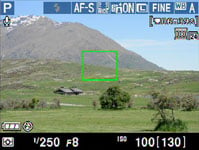 | 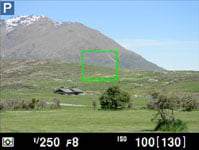 | 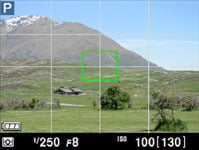 |
Pressing the Info button by the shutter release cycles through three display options: the default view shows basic shooting information in a black bar below the live image, with additional details super-imposed at the top. The second view removes the super-imposed details for a clean view of the image with basic exposure details below. Finally, the third view super-imposes a four-by-four alignment grid. Like other non-pro Nikon bodies, there’s no live histogram, which is beginning to feel lacking when one is available on entry-level models from other manufacturers. Suffice it to say there’s no virtual horizon either.
If you’re shooting in Auto, the D3100 exploits Live View to offer scene detection, picking from Portrait, Landscape, Close-up and Night Portrait presets, or reverting to plain Auto for subjects which aren’t recognised.
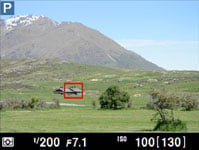 | 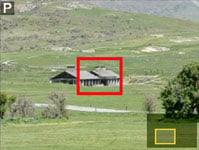 | 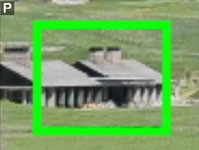 |
Pressing the magnifying glass button allows you to zoom-in on the view by up to about 6.8x, although like the D90 and D5000 before it, the magnified live image becomes increasingly fuzzy as you approach the closest view; it’s also worth noting that with a 320×240 pixel screen, the 6.8x view on the D3100 is not even showing the image at 1:1, let alone beyond it. If you then take the photo, playback the image and zoom-in to the same extent, the detail looks much finer. This implementation is in contrast to Canon’s Live View system, which shows a much sharper view when magnified to the same level or beyond. To be fair, Nikon’s magnified assistance still helps when confirming focus, but Canon’s system is far superior in this regard – and it offers a live histogram too.
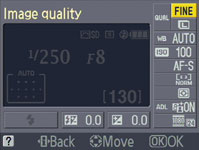 |
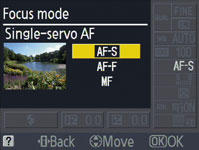 |
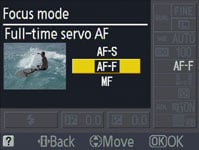 |
|
Pressing the ‘i’ button swaps the live image for the ‘classic’ information view which is also available when shooting with the viewfinder; note the shutter remains open at this time, but the live image is hidden. As before this shows the basic exposure details in a rectangle with numerous settings running down the right side, and in a strip below. You can then use the rocker control to highlight the desired option before pressing OK to see a dedicated menu for it. Pressing the ‘i’ button again returns you to the live image.
Autofocus during Live View exclusively employs a contrast-based system to ensure an uninterrupted view – unlike Canon’s DSLRs, there’s no ‘Quick’ mode which temporarily interrupts the live image in order to take a reading from the phase-change system. To be honest we don’t miss this option, as by the time the mirror has flipped back and forth, it’s rarely significantly quicker, and besides, a contrast-based system avoids any focus calibration errors by taking a reading from the sensor itself.
With the D3100 set to AF-S ‘Single-servo AF’, it will attempt to focus on whatever is within an adjustable rectangle with a half-press of the shutter release. The AF frame starts-off red to indicate it’s not in focus, then flashes green as it locks-on, before finally becoming steady once focus has been achieved. Like the D90 and D5000 before it, this process involves a little searching back and forth by the lens, before locking-on roughly two seconds later. Sometimes it’s a little quicker, sometimes a little slower.
New to the D3100, not to mention most DSLRs to date, is an attempt to offer continuous contrast-based autofocus during Live View. This new AF-F ‘Full-time Servo AF’ mode performs the process described above by itself whenever it believes the subject behind the AF frame is not in focus. Point the camera at a new subject and you’ll see the lens automatically search back and forth as it locks-on. Generally speaking it works fairly well too, so long as the subject has sufficient detail for the contrast-based system to lock-onto and stays still long enough for the process to complete. It’s technically no quicker than doing it with a half-press of the shutter release in AF-S mode, but could prove faster in practice as the camera’s already started the job as you compose. The AF-F mode is also responsible for the continuous AF in the movie mode which we’ll describe on the Features page.
In terms of AF targets and areas, the D3100 offers the same four options as the D5000 before it: there’s Face Priority, Wide Area (the default option), Normal Area, and Subject Tracking. Wide and Normal Area will autofocus on a framed area which you can move around the screen using the multi-selector; the Normal Area mode unsurprisingly uses a smaller frame and is better suited to tripod-based work. Face Priority can track faces and focus on the closest; like compact cameras, frames are shown around the active faces. Subject Tracking allows you to place a frame over a subject, and after pushing the OK button, the D3100 will follow it around the frame.
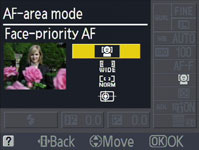 | 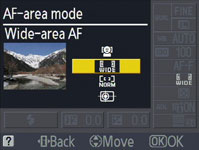 | 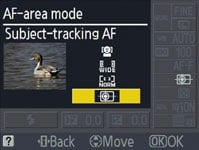 |
On previous models, Face Priority and Subject Tracking were of limited use, as while the camera could keep a frame over the desired subject, it wouldn’t actually focus on it until you half-pressed the shutter release. Now with the new AF-F mode, the camera can at least attempt to stay focused on the subject by itself as it moves closer toward you or further away. Of course the practicality remains restricted by the speed of the AF-F mode, which can take several seconds to make a readjustment and obviously requires the subject to remain fairly static during that time. This rules-out fast action tracking or unpredictable people, but slower motion or people who are willing to hold a pose are within the capabilities of the camera.
Ultimately the AF-F mode is a brave attempt to offer continuous AF with a contrast-based Live View system, but it’s too slow for many applications, especially sports or kids who won’t stay still for long. Of course both subjects can be successfully captured with the D3100’s viewfinder and phase-change AF system, but if you insist on going after them in Live View, you’ll be much better off with a hybrid system like those offered on many of Sony’s current models. Take the SLT-A33 for instance, which quickly and confidently autofocuses in Live View thanks to a translucent mirror exploiting the phase-change AF system.
Meanwhile, enthusiasts who enjoy a pin-sharp magnified view for precision focusing and live histograms will find neither on the D3100, and again be better-served by one of Canon’s DSLRs. But to be fair these and action shooters represent the minority of those using the D3100, who’ll instead find its Live View system perfectly adequate for general use. It’s definitely a very welcome upgrade over the D3000, but again those who had hopes for the AF-F mode allowing them to shoot fast action in Live View will need to reel in their expectations.
Nikon D3100 shooting information and menus
Like other budget DSLRs, the D3100’s screen is used to display all shooting information, and like its predecessor, there’s the choice of two presentation styles: the default Graphic format accompanies the figures with a graphical representation of the aperture iris surrounded by marks for the shutter speed, while the optional Classic format emulates the LCD status screens which adorn the top panels of higher-end DSLRs. It’s nice to have the choice of styles and you can even customise the colour scheme: Blue, Black or Orange for the Classic view, or Green, Black or Brown for the Graphic view.
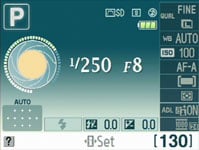 | 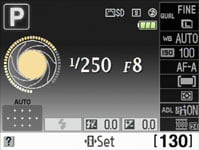 | 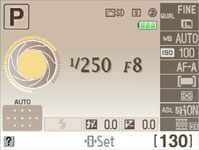 |
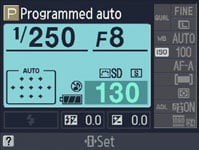 | 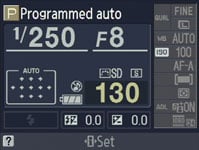 | 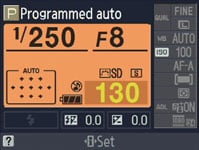 |
Like all DSLRs which use their main colour screens to show information, there’s a wealth of details, with the layout essentially unchanged since the D3000. The shutter speed and aperture sensibly take centre stage with shooting mode, battery life and a number of other icons running along the top, while AF area, flash, exposure and flash compensation run along the bottom. The shots remaining figure has been relocated to the very lower right corner in a light strip, and like all Nikon DSLRs, numbers above 1000 are abbreviated with a k – so 1100 shots is displayed as 1.1k, whereas Canon continues to stop at 999.
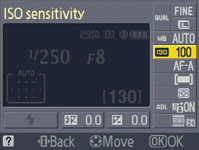 | 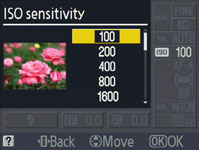 |
Running down the right side of the screen are the current quality, white balance, ISO, AF mode, AF area, metering mode and Active D-Lighting settings; eagle-eyed Nikon followers will note release mode is no longer present since it now has its own physical switch. To adjust any of the settings, simply press the ‘i’ button in the bottom left corner. This highlights one of the settings in yellow after which you can use the four-way rocker to highlight the desired option before clicking OK to see a screen of relevant options; each option is accompanied by a thumbnail image illustrating how or where you might use that setting.
The thumbnails are certainly helpful, but the number of button presses to access each setting can be a little laborious to say the least. For example, if the last setting you changed was the compression level, you’ll need three clicks to reach ISO or six for metering. This could have been so much easier by either assigning double-functions to the rocker control or simply rearranging the settings into a grid rather than a long straight line. The latter, employed by almost every other DSLR, would have transformed the speed at which the D3100 could be operated and adjusted. To be fair, its target audience may rarely change any of these settings, or be happy to do so at a leisurely pace, but enthusiasts or those familiar with the camera will find quickly find this frustrating.
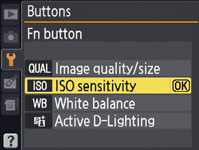 |
Some relief can be found with the programmable Fn button which can be set to offer direct access to the Image quality, ISO sensitivity, White Balance or Active D-Lighting options, but the D3100 could still be improved by leaps and bounds with a grid-based user interface on the screen.
In a nice feature borrowed from Sony’s Alpha DSLRs though (and originally from Konica Minolta before that), the D3100 rotates its shooting information as you turn the camera on its sides for portrait aspect shots – this way the text always remains upright on the screen. The graphical representation of the aperture may disappear as the screen rotates, and as soon as you press the ‘i’ button to change anything you’ll also be returned to the landscape orientation, but it’s still a nice touch. In these respects, it’s the same as the D3000.
Like its predecessor, the D3100 has also sensibly retained the context-sensitive help system which displays handy hints on the current setting or menu whenever you press the Question mark button. Sometimes you’ll see the question mark blinking in the corner of the screen, in which case the D3100 believes something’s wrong and wants to make a suggestion, such as to use the flash. If only all cameras were this friendly.
Pressing the Menu button presents the full array of options, arranged into five categories tabbed along the left side of the screen; the five menu categories, not to mention most of their contents, remain the same as the D3000, although they enjoy a redesigned appearance. As before, the five categories are Playback, Shooting, Setup, Retouch and Recent Settings, again with the Question mark in the lower left corner indicating there’s a helpful explanation if you need it.
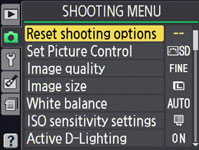 | 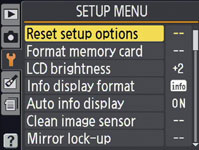 | 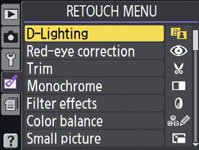 |
During playback you can cycle through a number of pages which have been updated in line with Nikon’s higher-end bodies. As such with all Display options ticked, you can view three pages of shooting information, a thumbnail with either brightness or RGB histograms, or the main image by itself, presented either clean or with blinking highlights.
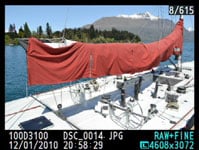 | 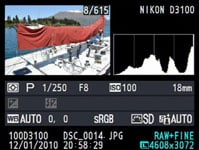 | 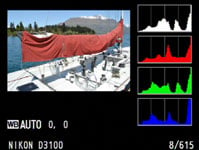 |
The Retouch menu offers a variety of in-camera adjustments which include D-Lighting, red-eye correction, crop, various filter effects, colour balance, image overlay, RAW processing, distortion control, an outlining effect and a Miniature option which throws everything other than a narrow strip out of focus for a tilt and shift effect.
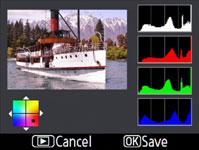 | 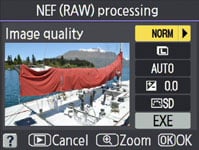 | 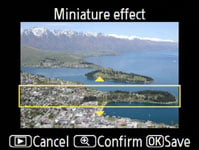 |
Now let’s move onto the camera’s other features, including the kit lens, focusing, exposure and drive modes, the sensor and of course the new movie mode in our Nikon D3100 Features page.
Nikon D3100 lenses, focus, sensor and drive
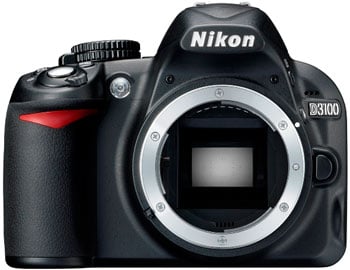 | |
|---|---|
The Nikon D3100 has an F-mount which can accommodate most Nikkor lenses, with the DX-format sensor resulting in their field of view being reduced by 1.5 times; so the DX 18-55mm VR kit lens delivers an effective focal range of 27-83mm.
As with all Nikon DSLRs, you’ll need recent lenses to support the full focusing and metering modes. There’s a compatibility chart in the D3100 manual or specification sheets, but just briefly you’ll need a Type G or D AF (including AF-S and AF-I) Nikkor to support all functions including the most sophisticated 3D Colour Matrix Metering II system.
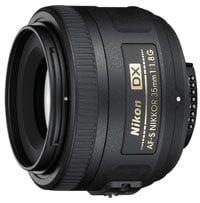 |
Like the D40(x), D60, D3000 and D5000, the D3100 does not feature a built-in motor required to auto-focus older lenses. These lenses will still work on the D3100, but they become manual-focus only. The D3100 will only auto-focus with AF-S or AF-I CPU lenses from the Nikkor range. If you want autofocus from third party lenses, look for models with built-in focusing motors like Sigma’s HSM series.
Like its predecessors, Nikon omitted the AF motor to save size, weight and cost, and while its absence will frustrate enthusiasts who want to use older lenses, it’s less of an issue for the D3100’s target audience which will mostly buy newer AF-S models.
Nikon’s steadily releasing more and more AF-S lenses including a number of new primes. A great complement for a kit zoom is the Nikkor AF-S DX 35mm f1.8 which delivers standard coverage, a bright aperture and very respectable image quality at a low price; see our Nikkor DX 35mm f1.8 lens review for full details. If the lack of a focusing motor really is a deal-breaker for you though, trade-up to the D7000 (or an older D90) instead.
The Nikon D3100 is typically sold in a kit with the Nikkor DX 18-55mm VR lens. The VR stands for Vibration Reduction and provides the lens with anti-shake capabilities which you can see through the viewfinder, although with a longest equivalent focal length of 83mm, any wobbling isn’t that obvious. We found the lens stabilisation was good for around three stops of compensation in practice.
Nikon D3100 focusing
Nikon’s D3100 inherits the same 11-point AF system as its predecessor, along with the D5000 and D90. This employs the same Multi-CAM 1000 module with a single cross-type sensor, and the options appear to be identical. As such there’s three main AF modes: AF-S (Single Servo AF), AF-C (Continuous Servo AF) and AF-A (an Auto mode which selects between them depending on whether the subject is in motion – this is the default option). These are selected from the main information display screen, where you’ll also be offered a Manual focusing option.
Unlike many affordable DSLRs which strobe their built-in flashes for AF assistance, the D3100 employs a dedicated lamp – it’s pretty bright, but much more discreet than the flickering flashes of Canon’s models.
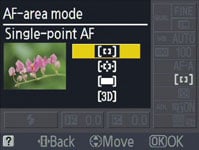 |
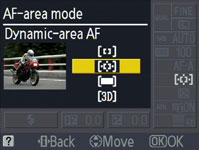 |
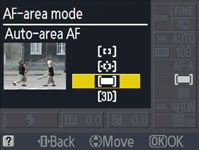 |
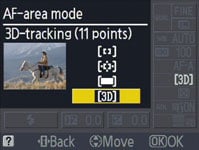 |
|
Like the D5000 before it, there’s four AF Area modes: Single Point, Dynamic Area, Auto Area, and 3D Tracking (the latter only available in AF-A and AF-C modes). In Single and Dynamic Area, you can manually adjust the focusing point using the rocker control, with Dynamic Area also considering surrounding focus points if the subject moves. In Auto Area, the D3100 chooses the focus point automatically.
With 3D Tracking, you manually select a focusing point and place it over the desired subject. With the shutter-release half-pressed, the D3100 will then attempt to keep this subject in focus even if you recompose the shot. 3D Tracking also exploits colour information to help track a subject, although obviously if it’s the same colour as the background, the system will become confused. Nikon recommends using Dynamic Area for erratically moving subjects, and 3D Tracking when recomposing photos with relatively static subjects.
We’ve detailed the Live View auto-focusing options on the previous Design page, but just briefly here, the D3100 exclusively relies on contrast-based AF in Live View, with the choice of four modes: Normal Area, Wide Area, Face Priority and Subject Tracking. New to the D3100 over previous models though is the choice of AF-S (Single) or AF-F (Full-time Servo) in Live View, where the latter attempts to continuously autofocus – again we have full details in our Live View section on the previous page.
Returning to the main 11-point phase-change AF system, the D3100 unsurprisingly performs identically to the D5000 and D90 before it. Set to the default Auto Area it generally does a good job of recognising the primary subject and locking the lens onto it, with the active AF points highlighted – albeit with red lights as opposed to the LCD graphics of the D5000 and D90. In Dynamic mode with AF-C, subjects placed under the manually chosen focus point are tracked effectively as they move towards or away from the camera.
Finally, the 3D Tracking option was effective at following subjects moving around the frame or as you recomposed with a static subject. This worked particularly well with strongly coloured subjects which stood out from the background, although as Nikon recommended, it’s best-suited to more leisurely motion. Technologically it’s also fun to watch the active AF point follow the subject around the frame, at least in the area covered by the 11 points, although in this regard Nikon’s higher-end models with their 51-point AF systems are ultimately more impressive.
As with all DSLRs which offer a variety of AF options, it’s a case of experimenting to see which works best for your particular application. But if you’re shooting a subject in motion and can keep it within the diamond area covered by the 11 AF points, the D3100’s Dynamic Area and 3D Tracking modes should keep it sharp. The only caveat is the supplied DX 18-55mm VR kit lens which as we’ve seen before is neither the quickest nor the quietest focuser in the range. If you demand snappier performance, or something quieter when recording movies, upgrade to a better model.
Finally, an interesting feature inherited from the D60 and D5000 is the Rangefinder option, enabled in the Custom Function menu. This uses the exposure compensation scale in the viewfinder (but not on the main screen) to indicate focus distance while manually focusing. As you approach perfect focus, the scale reduces to just two markers either side of zero. As you’d expect for a camera at this price-point though, there’s no AF micro-adjustment.
Nikon D3100 exposure modes and metering
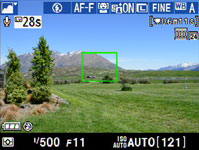 |
The Nikon D3100 shares the same exposure modes as its predecessor, although one has been enhanced. The main dial offers the traditional PASM modes, along with direct access to six scene presets, flash off, full Auto (with scene detection in Live View, see screenshot right) and the newly improved GUIDE mode, more of which in a moment; there’s no movie mode position on the dial as you can start shooting in any mode by simply entering Live View then pressing the red button on the rear.
 | |
|---|---|
The D3100 offers shutter speeds between 1/4000 to 30 seconds with a Bulb option in Manual; Program Shift is also available. Exposure compensation is available in a broader than average range of +/-5EV, but annoyingly – and bizarrely – there’s still no exposure bracketing on offer. Normally we’d excuse an entry-level DSLR for only offering three-frame bracketing with a +/-2EV range, but like its predecessor, the D3100 doesn’t offer any at all. You can of course just bracket by manually adjusting the required settings, but the absence of any automatic options feels like Nikon being deliberately awkward.
The Nikon D3100 shares the same three metering modes as the D60 and D5000 before it: Spot, Centre-weighted and 3D Colour Matrix II, the latter employing a 420-segment RGB sensor. Like most settings on the D3100, these are adjusted through the main information screen system. Note you’ll need a type G or D lens to deliver distance information for the 3D system, otherwise the D3100 falls back on Colour Matrix Metering II. We found 3D Matrix metering on the D3100 delivered consistently accurate exposures, although strangely the exception was our main real-life resolution composition which always seems to fool Nikon’s DSLRs into over-exposing – see our first results page.
Regardless of your shooting mode, the D3100 is a very friendly camera. Like its predecessor, the D3100 has sensibly retained the context-sensitive help system which displays handy hints on the current setting or menu whenever you press the Question mark button. Sometimes you’ll see the question mark blinking in the corner of the screen, in which case the D3100 believes something’s wrong and wants to make a suggestion, such as to use the flash. If only all cameras were this friendly.
The D3100 however goes one step further by inheriting – and enhancing – its predecessor’s innovative GUIDE mode which proudly has its own position on the main mode dial. Through a friendly graphical interface and series of questions, the GUIDE mode determines what kind of photo you want to take and then chooses the optimal settings to achieve the desired effect. It also teaches you as you go, allowing you to grow with the camera.
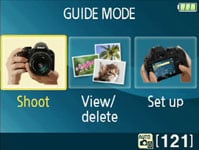 | 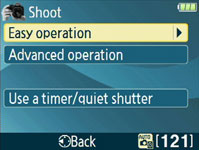 | 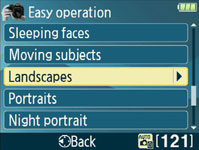 |
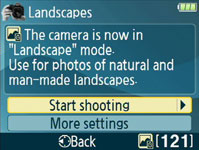 | 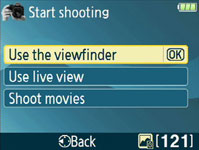 |
Like the D3000 before it, the D3100’s GUIDE mode starts with three main options: ‘Shoot’, ‘View / Delete’ and ‘Setup’. Choosing Shoot presents three options: ‘Easy Operation’, ‘Advanced Operation’ and ‘Use a timer / quiet shutter’. In the Easy Operation section the D3100 lets you choose from what are effectively nine scene presets: Auto, No Flash, Distant Subjects, Close-ups, Sleeping Faces, Moving Subjects, Landscapes, Portraits and Night Portraits. Some simply recognise that in the specified situation the flash or AF illuminator would either be unwelcome or redundant, so prevent it from operating.
The first difference between the D3100 and its predecessor though is once you select the option to ‘Start shooting’, the D3100 asks if you’d like to use the viewfinder, live view or record movies.
Things get more interesting in the Advanced Operation section, where you’re given the choice of ‘Soften Backgrounds’, ‘Bring more into focus’, ‘Freeze motion (people)’, ‘Freeze motion (vehicles)’ or ‘Show water flowing’; the latter and ‘Bring more into focus’ are new to the D3100. As you might expect, these options become friendly interfaces for using Aperture and Shutter Priority. ‘Soften Backgrounds’ and ‘Bring more into focus’ automatically switch the D3100 into Aperture Priority mode, and let you choose an f-number, with the camera explaining that lower f-numbers blur the background.
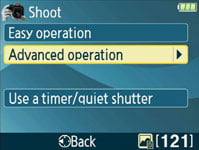 | 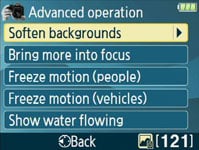 | 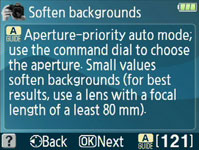 |
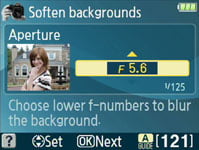 | 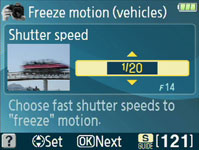 |
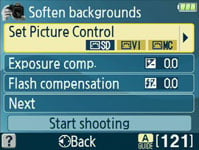 | 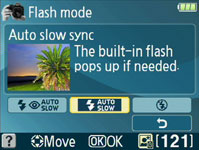 |
Similarly ‘Freeze motion’ or ‘Show water blurring’ switch the D3100 into Shutter Priority mode and allow you to adjust the shutter speed, with the camera advising shutter speeds should be chosen to ‘freeze’ motion. The people and vehicle options advise using shutter speeds of at least 1/200 or 1/1000 respectively.
What makes all these advanced options easier to use than its predecessor though are small thumbnail images which change to preview the effect of the current settings. Reduce the f-number on the ‘Soften backgrounds’ setting and you’ll see the background gradually become more blurred as the person in front of it remains sharp. Similarly in the Motion settings, you’ll see the subject gradually become more blurred as the shutter speed is reduced. This is really helpful stuff.
If you try and choose too fast a shutter speed or too small an aperture for the available light, the D3100 warns the subject will become too dark. Rather than automatically bumping up the sensitivity though, the D3100, like its predecessor sticks with a fixed value and ‘lets’ you change it manually later, which seems less helpful than it could have been. Once you’ve chosen the desired shutter or aperture value, the D3100 then asks if you’d like more settings, or start shooting. The more settings option lets you adjust the picture control, exposure compensation and flash compensation on a first page, followed by flash mode, release mode and sensitivity on a second page, each accompanied by thumbnail images showing how each might be used. Interestingly the AF mode option of the earlier D3000 has been removed.
The Timers / Quiet shutter section simply shows a photo of the top of the camera and tells you to turn the release mode switch to the desired position – yeah, thanks for that. Likewise, returning to the first page, the View / delete and Set up options present simplified versions of the normal menu sections for each.
In use, the Guide section certainly presents a beginner-friendly interface to operating the D3100, and we can imagine many first-timers leaving it on this mode most of the time. But it’s certainly not 100% foolproof across all the options. As mentioned above, the Advanced modes can let you dial-in an aperture or shutter speed which will result in under or over-exposure, and while the D3100 will warn you of this, the Guide mode won’t automatically adjust the sensitivity to solve at least some of these situations. For example if you choose to Freeze motion in the Advanced mode with too fast a shutter speed for the available light, the D3100 simply says the image will be too dark, rather than increasing the ISO to compensate, or at least suggesting it. A shame since the D3100 has its new Auto ISO option in other modes to get round similar problems.
We’re dwelling on this point since the stumbling-point for most beginners when first trying shutter and aperture priority, is getting an exposure that’s too bright or dark. Many understand that a big f-number will bring lots into focus and a quick shutter will freeze fast action, but they may not realise why shooting at f22 or 1/4000 may result in a dark image. The D3100 is in the ideal position to explain why and where possible even bump-up the ISO to compensate again with an explanation to its consequence. But like its predecessor, it holds back at this point and lets the photographer work it out for themselves.
This aside though, the D3100 remains one of the friendliest DSLRs on the market. The Auto mode works well, the scene presets provide the usual flexibility, while the GUIDE mode allows you to take more control and learn without becoming intimidated by too many technicalities. It’s arguably the best DSLR for beginners.
Nikon D3100 sensor and processing
In a major upgrade over its predecessor, the D3100 employs a new 14.2 Megapixel CMOS sensor. This gives the D3100 four extra Megapixels, along with a switch of sensor technology from CCD to CMOS; now the entire Nikon DSLR range employs CMOS technology.
The sensor measures 23.1×15.4mm, a fraction smaller than the CCD in the D3000, but still conforming to the DX standard, so all lenses effectively have their field-of-view reduced by 1.5 times. The D3100 delivers 3:2 shaped images with a maximum size of 4608×3072 pixels, giving the D3100 roughly 800 pixels more horizontally and 500 more vertically than its predecessor – this in turn allows you to make prints measuring 15.2×10.2in at 300dpi, compared to 12.9×8.6in on the D3000.
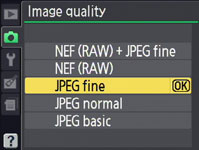 | 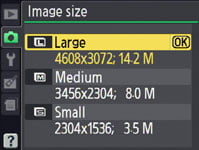 |
 | 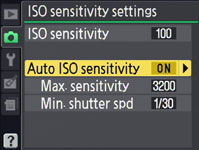 |
Images can be saved with Basic, Normal or Fine JPEG compression, or recorded as a 12-bit compressed RAW file either by itself or accompanied with a Fine JPEG. Best quality Large Fine JPEGs typically measure between 5.5 and 6.5MB each, while RAW files measure around 12MB each.
Like Nikon’s other consumer DSLRs, there’s only basic software supplied for converting RAW files – you’ll need to invest in Capture NX 2 or third party software to perform more sophisticated processing. On the upside, the D3100 allows processing of RAW files in-camera, although you can only adjust the resolution, compression, white balance, exposure compensation and the Picture Control.
With a new sensor comes a new ISO range, with the D3100 offering 100 to 3200 ISO in single EV increments with Hi 1 and Hi 2 options delivering equivalents of 6400 and 12800 ISO. An Auto ISO option allows you to enter a maximum sensitivity and minimum shutter speed, and if enabled, will kick-in for PASM modes when the selected sensitivity fails to allow the desired shutter speed. Auto ISO can choose from sub-1EV increments and is the fixed option for the Auto exposure modes. In practice we found Auto ISO regularly opted for relatively high sensitivities around 1000 ISO, even when using the flash for close-range portraits, so if you want to maximise the quality you may want to reduce the upper limit.
Noise Reduction is On by default and applied to long exposures or high sensitivities. Even if you disable it though, it’s still applied at very high sensitivities, albeit to a lesser degree.
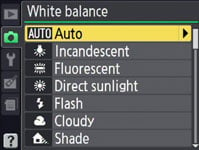 | 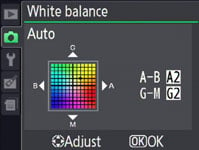 |
Image processing duties are carried out by Nikon’s EXPEED processor. White Balance can be set to Auto, Incandescent, Fluorescent, Direct Sunlight, Flash, Cloudy, Shade or a custom preset. The D90’s manual entry of colour temperature is not available here, but its impressive choice of seven Fluorescent sub-categories remains present, as do the fine tuning facilities for the other presets.
Like other recent Nikon DSLRs, EXPEED automatically removes – or at least greatly reduces – the effect of lateral chromatic aberrations, also known as purple fringing. This correction is applied automatically to all JPEG files whether you like it or not, but not to RAW files; it’s very effective in practice as you can see by the absence of fringing in our samples and results images. Canon, please take note and offer automatic corrections of fringing in-camera; the EOS 60D’s option to do so when processing RAW files is a step in the right direction, but it really needs to be done automatically on JPEGs.
The Vignette control of higher-end models is still not available in-camera (although it can be applied using Capture NX 2), but the D3100 inherits the D5000’s Auto Distortion Control. This applies digital correction for barrel and pincushion geometric distortion, where straight lines can appear to bend outwards or inwards towards the edge of the frame. It would appear to be the same option offered in the Playback Retouch menu, but applied automatically to JPEGs as they’re generated. It’s visually impressive at reduced sizes, but remember such adjustments involve significant pixel-wrangling with potential loss of quality or a slightly cropped image. It’s sensibly disabled by default.
The D3100’s Retouch section also offers Perspective control to straighten the converging edges of subjects when the camera’s pointed upwards – although again like Distortion control, this will stretch portions of the image with quality artefacts as a result.
| ||||||||||||||||
|---|---|---|---|---|---|---|---|---|---|---|---|---|---|---|---|---|
The headline processing feature remains Active D-Lighting which adjusts the tonal curve of images in an attempt to boost darker areas without blowing highlights.
Unlike the D5000 which offered a variety of settings though, Active D-Lighting is either on or off on the D3100. On is the default option, so the one we’ve used in our main Results and Gallery pages, however since it can introduce noise to dark areas, we disabled it for our High ISO Noise results page.
You can see two examples on the left, showing roughly the same handheld composition without Active D-Lighting (far left), and with Active D-Lighting (left). Both were taken in Aperture Priority at f5.6 and 100 ISO, where the camera metered an exposure of 1/100. So both pictures share exactly the same exposures.
It’s quite clear how Active D-Lighting has brightened the dark fencing, while darkening the bright blossom and background hills. These changes are reflected in the histograms below each image. While there’s still a little highlight clipping, the image with Active D-Lighting is preferred over that without.
More traditional image processing options are applied using a series of six Picture Controls, matching those on the D5000 and D90, with the same degree of adjustment too. The Standard, Neutral and Vivid, Portrait and Landscape Picture Controls all offer adjustment of Sharpening (0-9), Contrast (+/-3), Brightness (+/-1), Saturation (+/-3) and Hue (+/-3), while the Monochrome Picture Style swaps Saturation and Hue for nine Toning and four Filter Effects, the former fine-tunable by seven values. If Active D-Lighting is enabled, it takes over the Contrast and Brightness settings, and if you’re in a real hurry, a Quick Adjust option can boost or lessen a group of settings in one go.
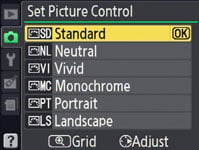 | 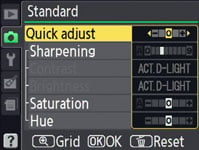 | 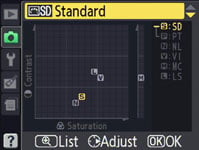 |
As always we used the default processing option for our test shots – in this instance the Standard Picture Control. As you’ll see in our Results and Sample Images Gallery pages, the D3100’s default JPEG output, like other recent Nikon DSLRs, is fairly restrained and laid back. This delivers very natural-looking images, but we can’t help but feel its target audience would prefer something more vibrant and punchy. Fortunately that’s easily achieved by tweaking the Picture Controls, or simply selecting the Vivid preset. Better still, shoot in RAW and make the adjustments later.
Nikon D3100 drive modes and remote control
The D3100 offers four ‘release’ modes: Single frame, Continuous, Self-timer and Quiet shutter release. Rather than use buttons to select them though, Nikon’s fitted the D3100 with a rather classy lever on the right side of the main mode dial. This chunky tactile control makes it very quick and easy to check and adjust the release mode – it’s an unexpected but welcome upgrade over most entry-level models.
 | |
|---|---|
Switch the lever to Continuous and the D3100 can shoot at 3fps with a buffer that can accommodate up to 100 Large Fine JPEGs, 13 RAW files or nine shots taken in RAW+JPEG mode. To put this to the test we fitted the D3100 with a freshly-formatted 8GB Lexar Professional 133x SDHC card, rated at Class 6.
With the D3100 set to Large Fine JPEG, we fired-off 50 frames in 17 seconds with no sign of the camera slowing – this corresponds to a rate of 2.94fps. Set to RAW, we managed 16 frames in 5.5 seconds before the camera stalled, which corresponds to 2.9fps. Finally in RAW + Fine JPEG we fired-off 11 frames in just under four seconds, again corresponding to a fraction below 3fps. In each case we shot at 100 ISO and the buffer took around 15 seconds to completely clear.
As such we’re pretty satisfied the D3100 delivers its quoted continuous shooting speed of 3fps. The JPEG rate matches that of the Canon EOS 1000D / XS, although that model slows down when shooting RAW. The D3100 is however more expensive than the Canon, so a fairer comparison would be with models costing roughly the same. Nikon’s D5000 for instance was similarly-priced at the time of writing, but offered 4fps continuous shooting. While Canon forces you to spend considerably more for models like the EOS 60D to enjoy significantly faster continuous shooting, Sony offers a number of mid-range models with very quick burst speeds which only cost a little more than the D3100.
|
The bottom line is the D3100 may offer a step-up from entry-level DSLRs in many respects, but continuous shooting isn’t one of them. Considering it’s priced higher than budget models, this is a bit of a disappointment. Three frames per second is pretty basic, and most action or sports sequences will be over before you’ve managed to fire-off more than a couple of shots. So if action photography is your thing, we’d recommend going for the D5000, or spending a little more on one of Sony’s models instead.
Flick the release lever one notch further and the D3100 goes into self-timer mode, with the choice of either two or ten seconds selected from a menu. The five and 20 second options of the D5000 are absent here, as is the ability to take up to nine shots once the countdown is complete.
The final position on the D3100’s release mode lever is Quiet shutter release. This takes the photo as normal when you press the shutter release, but doesn’t reset the mirror until you let go – so you could press the shutter release to take the shot, but keep the button held until you’re somewhere less quiet. Obviously during that time you won’t be able to take any more photos.
In practice if you press and let go of the shutter release as normal, you’ll notice virtually no difference in this Quiet mode, but by pressing and holding the shutter release, the mechanical sound is slightly reduced – or at least delayed. To be honest though it made very little difference in our tests. Probably the greatest benefit was that Quiet mode automatically switched off any beeps, so it could be a quick fix in certain situations.
As you’d expect for an entry-level model, the interval timer facilities of the D5000 aren’t available on the D3100, and neither is the stop motion movie mode; clearly these advanced release modes, along with the different self-timer options are reserved for the D5xxx line and above. And while there is a mirror lockup function, its purpose, like the D3000 before it, is only to clean the sensor.
Like other Nikon DSLRs, the supplied software bundle is also lacking compared to Canon’s models. You do get View NX for basic manipulation and RAW processing, but for more powerful features, you’ll want the optional Capture NX software, while for remote control using your computer, you’ll also have to pay extra for the Camera Control 2 package. In contrast, Canon supplies all of its DSLRs from entry-level to top professional models with its powerful Digital Photo Professional software and the EOS Utility, the latter offering complete remote control over a USB cable.
What you do now get on the D3100 though is an HD movie mode, and we’ve devoted an entire page to it. So to find out the full details, please see our Nikon D3100 Movie Mode page. Alternatively if you’re not interested in movies, find out how the D3100 compares against its rivals in terms of image quality in our results pages and sample images gallery. Or if you’ve already seen enough, head straight to our verdict.
Nikon D3100 Movie Mode
The Nikon D3100 becomes the latest DSLR to feature an HD movie mode. It’s a major upgrade over its predecessor which didn’t even offer Live View, let alone video capture. This also gives the D3100 a crucial advantage over Canon’s entry-level EOS 1000D / XS, which doesn’t offer a movie mode, although it’s important to remember the D3100 is priced closer to the EOS 500D / T1i which does have video.
Nikon was the first company to offer HD video recording on a DSLR, with a 720p / 24fps / Motion JPEG mode on the D90 back in October 2008. The movie capabilities of the D90 were duplicated for the D5000 and the D300s after that, with only minor upgrades, such as an articulated monitor on the D5000 and an external microphone input and in-camera cropping on the D300s.
While Nikon’s core movie capabilities essentially stood still for two years though, Canon took the ball and ran with it. Now models from the affordable EOS 550D / T2i upwards boast 720p and 1080p at a choice of frame rates, external microphone inputs and longer recording times, while the EOS 5D Mark II has become the darling of independent film makers, commonly pimped-up with pro accessories and used on high profile shoots. So while it’s fair to say Nikon started the ball rolling for DSLR video, Canon quickly swooped-in and captured the professional market.
As such it’s not surprising to find Nikon revamping the movie mode capabilities and experience on the D3100. Previous Nikon DSLRs offered a best quality movie mode of 720p at 24fps, but now the D3100 offers the same resolution at the choice of 24, 25 or 30fps, while crucially adding a new Full HD 1080p mode at 24fps.
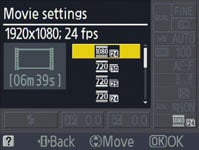 | 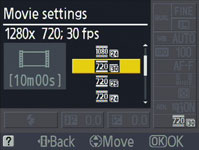 | 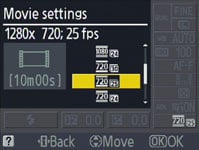 |
Nikon’s also ditched the previous Motion JPEG encoding which may have been easy to edit, but suffered from larger files and HD recording times limited to five minutes. Now it uses the same H.264 format as Canon and supports clips up to ten minutes each (regardless of resolution). Most impressively of all, the D3100 becomes the first DSLR to attempt continuous autofocusing while filming. There’s lots to discuss below, but before we launch into the fine details, let’s check out our first clip.
| |
|---|---|
|
In the handheld clip above the first thing to notice is the lack of vertical streaking around the sunlight reflections on the water – this is a benefit of a camera with a CMOS sensor. But if you’re playing the file with audio, you’ll almost immediately notice a faint squeaking or scratching in the background. This is the sound of the kit lens constantly being refocused by the D3100’s new AF-F continuous autofocus mode, and it’s quite audible on this clip.
Unfortunately in this example, the continuous autofocus isn’t doing a great job either, regularly searching for a subject with sufficiently strong contrast for it to lock onto. So while the actual video quality itself is fine, the continuous AF option hasn’t performed so well in this example; indeed disabling it would have probably produced better results. But before you write-off the D3100’s AF-F mode, check the clips below as it can work reasonably well under the right conditions. PS – at the end of the clip we’ve attempted to smoothly zoom the lens in and out, and as usual this is an almost impossible task with a handheld DSLR.
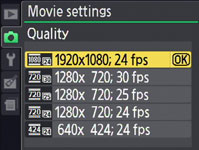 |
 |
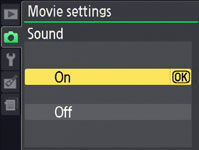 |
|
With this first example out of the way, let’s take a look at the specifics. Like previous Nikon DSLRs with video capabilities, the D3100’s Movie mode works as an extension to Live View. So first you’ll need to enter Live View by flicking the new spring-loaded lever on the back of the camera. Then to start recording, simply press the red button in the middle of the lever, before pressing it again to stop.
Unlike Canon’s latest models, there’s no dedicated manual exposure mode, and the D3100’s instructions make no mention of any aperture or shutter control. We do however understand the D3100 is similar to earlier Nikon DSLRs, whereupon an aperture selected in manual or aperture priority prior to entering Live View, will be adopted by the movie mode. Once you’re in Live View though, the aperture cannot be changed for movies. Nikon tells us the ISO can also be manually set prior to entering Live View, but clearly there’s an automatic override to avoid shutter speeds that are too slow. Speaking of which, the shutter speed in the movie mode is automatic.
The D3100 offers five movie quality options which can be adjusted in any mode: 1080p at 24fps, 720p at 30, 25 or 24fps, and a 640×424 option at 24fps; pros will be relieved to discover the 24 and 30fps modes actually record at 23.976 and 29.97fps to match other pro equipment, but unlike Canon’s 550D / T2i upwards, there’s no additional options to record 1080p at 25 or 30fps, nor 720p at 50 or 60fps.
As stated above, the maximum recording time in any of the D3100’s quality modes is ten minutes, or when the file reaches 4GB in size. You’re looking at about 2.3MB per second (or around 140MB per minute) in the best quality 1080p mode, which means the ten minute limit will be reached with a file measuring around 1.4GB.
Nikon recommends using a Class 6 card or quicker for HD movies; we used a Lexar Professional 8GB 133x SDHC card in our tests with no problems, and confirmed the ten minute limit with a 1080p file measuring 1.29GB. Note Canon’s HD movie modes are much more memory-hungry, consuming almost two and a half times as much data at 330MB per minute thanks to higher bit rates. That said, there’s no ten minute limit on the Canons, so their 4GB file size will be reached after around 12 minutes of HD filming.
Audio on the D3100 is recorded in mono only, using the built-in microphone; sadly unlike the Canon 550D / T2i upwards, there’s no external microphone input, and unsurprisingly no manual control over audio levels either. The video and audio are encoded using H.264 and stored in a Quicktime MOV wrapper – this is the same compressor as Canon, but used at a lower bit rate for smaller file sizes. Like Canon’s MOV files, we found VLC Player proved best for playback under Windows.
You can take a photo with the D3100 while filming, but there’s a pause between pressing the button and the image being captured – and it will also stop your recording.
| |
|---|---|
|
In our second clip, above, we’ve mounted the D3100 on a tripod, disabled VR and AF on the kit lens and smoothly panned from left to right. Despite being a little over-exposed (like the same shot in our Outdoor results page), there’s plenty of detail here, and we’ve also paused at the start in case you’d like to grab a frame for closer analysis. We also filmed the same sequence moments later in the three 720p modes, so if you’d like to compare them, check out our 720p / 24fps, 720p / 25fps and 720p / 30fps clips.
| |
|---|---|
|
Moving on, our third clip above was filmed handheld in a relatively dim bar with both VR and AF-F enabled, although thankfully the latter doesn’t appear as confused by the subject matter as in the first clip.
 |
It’s fair to say lots of people had high hopes for the new Full-time servo AF-F mode on the D3100 and its more sophisticated counterpart the D7000. In theory this allows both cameras to continuously autofocus while filming, a capability which has eluded traditional DSLRs to date. For example, while Canon’s latest DSLRs support autofocusing while filming, it’s a Single AF operation which is initiated by hand and takes several seconds to lock-on thanks to the leisurely contrast-based AF system. Theoretically you could just keep forcing a Canon DSLR to repeatedly perform this process in an attempt to keep the subject sharp during a clip, but it wouldn’t look pleasant with constant visual searching, not to mention the sound of the lens doing it.
If you’ve watched the first clip above though, you’ll know this is effectively what’s happening with the Nikon D3100’s AF-F mode, albeit the difference here is the camera initiates the AF process, not the photographer. The D3100’s AF-F mode works exactly the same way in movies as it does within Live View. It immediately checks the selected AF area and if it’s not sufficiently sharp, it’ll use the contrast-based AF system to focus on it. Depending on the subject though, this could take an average of two seconds each time with the lens typically searching back and forth at least twice. If your lens has audible autofocusing, like the DX 18-55mm VR kit lens, you’ll also hear this squeaky scratching sound recorded quite clearly in your movies. And if the subject regularly moves, the camera will keep trying to lock-onto it, which means your video could suffer from a lot of visual searching, and of course the sound of it too. Our next clip better illustrates how the system works and what kind of response you can hope for.
| |
|---|---|
|
Our fourth clip, above, deliberately put the new AF-F mode to the test. Here we moved the camera around, pointing it at various subjects near and far to see how the continuous autofocus coped. At first it doesn’t seem to do very well, refusing to focus on the coffee cup until the composition was readjusted. But give the D3100 some sharp edges for its contrast-based AF system to lock-onto and it can actually do quite a good job. Sometimes the focusing searches a little, but at others it feels more confident as it locks-onto the desired subject.
Indeed as the clip progresses, it’s hard not to be quite impressed by the AF-F mode as it succeeds more than it fails. It may not be as consistent as a consumer camcorder, nor as confident as the phase-change AF on the Sony Alpha A33, but the D3100 still manages to keep the subject mostly focused as the composition changes, while the ambient background sounds in this clip mostly mask the kit lens’s AF motor. This is an impressive capability for a camera that only has a contrast-based AF system at its disposal while filming (along with the challenges of a shallower depth-of-field than a camcorder); remember Canon’s DSLRs don’t even attempt to continuously autofocus while filming, making this clip impossible without constant manual adjustments.
| |
|---|---|
|
In our fifth clip, above, we’ve given the D3100 a more predictable subject to track with its continuous AF. We zoomed the kit lens to 55mm, selected the D3100’s central AF point only, and kept it positioned over the Skyline logo on the cable car as it steadily approached.
Like most contrast-based AF systems, the D3100 searches back and forth as it attempts to lock-on, and this is quite visible at several points during the clip. This is undoubtedly off-putting, but to be fair, the D3100 does manage to keep the logo relatively sharp throughout the clip, even when it’s only a meter or so distant. Once again this is something which would have required constant manual focus pulling on a Canon DSLR. So while the D3100’s continuous AF during filming may not live up to the experience of a consumer camcorder (nor the unique capabilities of the Sony Alpha A33), it remains a very impressive attempt given the available resources.
|
That said, for subjects where the soundtrack was critical or the subject remained mostly at a fixed distance, we switched the D3100 to manual (or single) focus. When AF-F works well, it’s pretty neat, but more often than not it spoilt our clips with its constant searching. Indeed once you’ve seen and heard the effect of the kit lens constantly search back and forth on clips, you’ll find it some relief to simply switch it off.
As for the quality, the 1080p mode looks similar to comparable DSLRs, although complex scenes will benefit from the higher bit rates used by Canon. That said, the D3100, like all DSLRs tested to date, is equally susceptible to the dreaded jello effect when the camera’s wobbled or twisted. Some will also find it a shame there’s no alternative frame rates for 1080p at 25 and 30fps. We understand independent film makers will be most interested in having 24fps, but there’s plenty of other users who’d have found 25 and 30fps options better for integrating with existing camcorder footage. It’s also a little inconsistent to suggest 24fps is the professional’s choice, then offer 25 and 30fps at 720p. And lest we forget, this is an entry-level DSLR, which is unlikely to be used for many pro projects.
Two things which really hold the D3100 back for pros and enthusiasts alike are the lack of a microphone input and definitive manual control over exposures. Both are offered on the higher-end D7000 though, albeit again with 1080p only available at 24fps.
Overall though the D3100’s movie mode is pretty respectable, but if you ignore the AF-F mode (which you probably will on most of your clips), then models like Canon’s EOS 550D / T2i upwards are ultimately more capable. They may effectively become manual focus only, but offer 720p at higher frame rates, 1080p at the choice of three rates, higher resolution screens, external microphone inputs for considerably superior sound quality, higher bit rates for better video quality and slightly longer maximum clip lengths. Alternatively if decent continuous autofocus is your priority while filming, then Sony’s SLT A33 becomes your top choice.
Now find out how the D3100 compares against its rivals in terms of image quality in our results pages and sample images gallery. Alternatively if you’ve already seen enough, head straight to our verdict.
